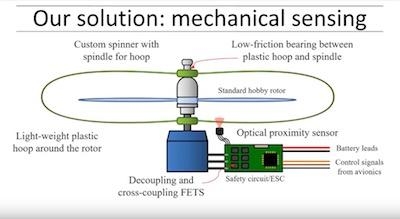Wed, Jun 06, 2018
Senses Proximity Of Biological Material To The Blades
Researchers at the University of Queensland in Australia are developing a sensor system that is designed to stop a spinning drone rotor blade before it can cause an injury.

The "Safety Rotor" is a cage around the rotor that spins more slowly than the propeller, and if a biological material is detected, stops the rotor within 0.077 seconds.
IEEE reports on its Spectrum website that the system consists of a plastic hoop that would touch any object, such as a finger, before it is contacted by the rotor blade. The hoops are spun passively by friction against the rotor hub and studded with IR reflectors that interface with an IR detector mounted near the rotor hub. If the IR signal is interrupted, it engages the rotor brake.
The system is expected to cost about $14 and weigh under 22 grams, so drone performance would not be impacted significantly.
According to the researchers:
"The measured latency [of the Safety Rotor’s braking response] was 0.0118 seconds from the triggering event to start of rotor deceleration. The rotor required a further 0.0474 s to come to a complete stop. Ninety percent of the rotational kinetic energy of the rotor (as computed from angular velocity) was dissipated within 0.0216 s of triggering, and 99 percent of the rotational kinetic energy of the rotor was dissipated within 0.032 s.
"The safety functionality of the safety system was tested on the bench using a processed meat “finger” proxy to trigger the hoop, and also applied to an open rotor (without hoop) for comparison. The rotor was spun at hover speed (1100 rads−1) and the finger proxy was introduced into the hoop at 0.36 ms−1 … The rotor and finger motion were captured using a shutter speed of 480 Hz. The rotor came to a stop within 0.077 s, with only light marks on the finger proxy from the impact of the hoop. The rotor was completely stopped by the time the finger reached the rotor plane. In contrast, the tip of the finger proxy introduced to an open rotor was completely destroyed."
(Image from University of Queensland YouTube video)
More News
Takeoff Roll The process whereby an aircraft is aligned with the runway centerline and the aircraft is moving with the intent to take off. For helicopters, this pertains to the act>[...]
“We’re proud of the hard work that went into receiving this validation, and it will be a welcome relief to our customers in the European Union. We couldn’t be mor>[...]
"Aircraft Spruce is pleased to announce the acquisition of the parts distribution operations of Wag-Aero. Wag-Aero was founded in the 1960’s by Dick and Bobbie Wagner in the >[...]
IDENT Feature The special feature in the Air Traffic Control Radar Beacon System (ATCRBS) equipment. It is used to immediately distinguish one displayed beacon target from other be>[...]
Aero Linx: Pararescue Air Force Pararescuemen, also known as PJs, are the only DoD elite combat forces specifically organized, trained, equipped, and postured to conduct full spect>[...]
 ANN's Daily Aero-Term (05.10.24): Takeoff Roll
ANN's Daily Aero-Term (05.10.24): Takeoff Roll Aero-News: Quote of the Day (05.10.24)
Aero-News: Quote of the Day (05.10.24) Aero-News: Quote of the Day (05.11.24)
Aero-News: Quote of the Day (05.11.24) ANN's Daily Aero-Term (05.11.24): IDENT Feature
ANN's Daily Aero-Term (05.11.24): IDENT Feature ANN's Daily Aero-Linx (05.11.24)
ANN's Daily Aero-Linx (05.11.24)



